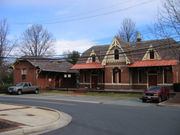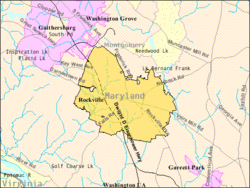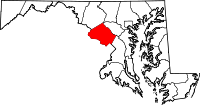Rockville, Maryland
| Rockville, Maryland | |||
|---|---|---|---|
| — City — | |||
 |
|||
|
|||
 |
|||
| Coordinates: | |||
| Country | United States | ||
| State | Maryland | ||
| County | Montgomery | ||
| Settled | 1717 | ||
| Incorporated | 1860 | ||
| Government | |||
| - Mayor | Phyllis Marcuccio (I) | ||
| Area | |||
| - City | 13.4 sq mi (34.8 km2) | ||
| - Land | 13.4 sq mi (34.8 km2) | ||
| - Water | 0 sq mi (0 km2) | ||
| Elevation | 451 ft (137 m) | ||
| Population (2010) | |||
| - City | 62,476 | ||
| - Density | 4,532.4/sq mi (1,745.2/km2) | ||
| - Metro | 5,306,565 | ||
| Time zone | EST (UTC-5) | ||
| - Summer (DST) | EDT (UTC-4) | ||
| Area code(s) | 301, 240 | ||
| FIPS code | 24-67675 | ||
| GNIS feature ID | 0586901 | ||
| Website | http://www.rockvillemd.gov/ | ||
Rockville is the county seat of Montgomery County, Maryland, United States. It is a major incorporated city in the central part of Montgomery County and forms part of the Baltimore-Washington Metropolitan Area. According to estimates conducted by the U.S. Census Bureau for a 12-month period ending 1 July 2008, the city's population is 60,734, making it the second largest incorporated city in Maryland, behind Baltimore.[1]
Rockville, along with neighboring Gaithersburg and Bethesda, is at the core of the Interstate 270 Technology Corridor which is home to numerous software and biotechnology companies as well as several federal government institutions. The city also has several upscale regional shopping centers and is one of the major retail hubs in Montgomery County.
Contents |
History
Situated in Piedmont region and crossed by three creeks (Rock Creek, Cabin John Creek, and Watts Branch), Rockville provided an excellent refuge for semi-nomadic Native Americans as early as 8000 BC. By the first millennium BC, a few of these groups had settled down into year-round agricultural communities that exploited the native flora, including sunflowers and marsh elder. By AD 1200, these early groups (dubbed Montgomery Indians by later archaeologists) were increasingly drawn into conflict with the Senecas and Susquehannocks who had migrated south from Pennsylvania and New York. Within the present-day boundaries of the city, six prehistoric sites have been uncovered and documented, and borne artifacts several thousand years old. By the year 1700, under pressure from European colonists, the majority of these original inhabitants had been driven away.
The indigenous population carved a path on the high ground, known as Sinequa Trail, which is now downtown Rockville. Later, the Maryland Assembly set the standard of 20 feet for main thoroughfares and designated the Rock Creek Main Road or Great Road to be built to this standard. In the mid-1700s, Lawrence Owen opened a small inn on the road. The place, known as Owen's Ordinary, took on greater prominence when, on April 14, 1755, Major General Edward Braddock stopped at Owen's Ordinary on a start of a mission from George Town (now Washington, D.C.) to press British claims of the western frontier. The location of the road, near the present Rockville Pike, was strategically located on higher ground making it dry year-round.[2]:6-9
The first land patents in the Rockville area were obtained by Arthur Nelson between 1717 and 1735. Within three decades, the first permanent buildings in what would become the center of Rockville were established on this land. Still a part of Prince George's County at this time, the growth of Daniel Dulaney's Frederick Town prompted the separation of the western portion of the county, including Rockville, into Frederick County in 1748.
Being a small, unincorporated town, early Rockville was known by a variety of names, including Owen's Ordinary, Hungerford's Tavern, and Daley's Tavern. The first recorded mention of the settlement which would later become known as Rockville dates to the Braddock Expedition in 1755. On April 14, one of the approximately two thousand men who were accompanying General Braddock through wrote the following: "we marched to larance Owings or Owings Oardianary, a Single House, it being 18 miles and very dirty." Owen's Ordinary was a small rest stop on Rock Creek Main Road (later the Rockville Pike), which stretched from George Town to Frederick Town, and was then one of the largest thoroughfares in the colony of Maryland.

On September 6, 1776, the Maryland Constitutional Convention agreed to a proposal introduced by Thomas Sprigg Wootton wherein Frederick County, the largest and most populous county in Maryland, would be divided into three smaller units. The southern portion of the county, of which Rockville was a part, was named Montgomery County. The most populous and prosperous urban center in this new county was George Town, but its location at the far southern edge rendered it worthless as a seat of local government. Rockville, a small, but centrally located and well travelled town, was chosen as the seat of the county's government. Thereafter, the village was referred to by all as Montgomery Court House.

In 1784, William Prather Williams, a local landowner, hired a surveyor to lay out much of the town. In his honor, many took to calling the town Williamsburgh. In practice, however, Williamsburgh and Montgomery Court House were used interchangeably. Rockville came to greater prominence when Montgomery county was created and later when George Town was ceded to the create the District of Columbia.[2]
On July 16, 1803, when the area was officially entered into the county land records, however, the name used was "Rockville," believed to be derived from Rock Creek. Nevertheless, the name Montgomery Court House continued to appear on maps and other documents through the 1820s.
By petition of Rockville's citizens, the Maryland General Assembly incorporated the village on March 10, 1860. During the American Civil War, General George B. McClellan stayed at the Beall Dawson house in 1862. In addition, General J.E.B. Stuart and an army of 8,000 Confederate cavalrymen marched through and occupied Rockville on June 28, 1863 while on their way to Gettysburg and stayed at the Prettyman house. Jubal Anderson Early had also crossed through Maryland, on his way to and from his attack on Washington.
In 1873, the Baltimore and Ohio Railroad arrived, making Rockville easily accessible from Washington, D.C. (See Metropolitan Branch.) In July 1891, the Tennallytown and Rockville Railway inaugurated Rockville's first trolley service connecting to the Georgetown and Tennallytown Railway terminus at Western Avenue and Wisconsin Avenue.

This provided service from Georgetown to Rockville, connecting Rockville to Washington, D.C. by trolley. Trolley service operated for four decades, until, eclipsed by the growing popularity of the automobile, service was halted in August 1935. The Blue Ridge Transportation Company provided bus service for Rockville and Montgomery County from 1924 through 1955. After 1955, Rockville would not see a concerted effort to develop a public transportation infrastructure until the 1970s, when the Washington Metropolitan Area Transit Authority (WMATA) began work to extend the Washington Metro into Rockville and extended Metrobus service into Montgomery County. The Rockville station of Washington Metro began service on July 25, 1984, and the Twinbrook station began service on December 15, 1984. Metrobus service was supplemented by Montgomery County's own Ride On bus service starting in 1979. MARC, Maryland's Rail Commuter service, serves Rockville with its Brunswick line. From Rockville MARC provides service to Union Station in Washington D.C. (southbound) and, Frederick and Martinsburg, West Virginia (northbound), as well as intermediate points. Amtrak, the national passenger rail system, provides service from Rockville to Chicago and Washington D.C.
During the Cold War, it was considered safer to remain in Rockville than to evacuate during a hypothetical nuclear attack on Washington, D.C. Bomb shelters were built, including the largest one at Glenview Mansion and 15 other locations. The I-270 highway was designated as an emergency aircraft landing strip. Two Nike missile launcher sites were located on Muddy Branch and Snouffer School Roads until the mid-1970s.[2]:163
From the 1960s, Rockville's town center, formerly one of the area's commercial centers, suffered from a period of decline. Rockville soon became the first city in Maryland to enter into a government funded urban renewal program. This resulted in the demolition of most of the original business district. Included in the plan was the unsuccessful Rockville Mall, which failed to attract either major retailers or customers and was demolished in 1994, various government buildings such as the new Montgomery County Judicial Center, and a reorganization of the road plan near the Courthouse. Unfortunately, the once promising plan was for the most part a disappointment. Although efforts to restore the town center continue, the majority of the city's economic activity has since relocated along Rockville Pike (MD Route 355/Wisconsin Avenue). In 2004, Rockville Mayor Larry Giammo announced plans to renovate the Rockville Town Square, including building new stores and housing and relocating the city's library. In the past year, the new Rockville Town Center has been transformed and includes a number of boutique-like stores, restaurants, condominiums and apartment, as well as stages, fountains and the Rockville Library.[3] The headquarters of the U.S. Public Health Service is on Montrose Road, while the U.S. Nuclear Regulatory Commission's headquarters are also in the city.
The city is closely associated with the neighboring towns of Kensington and the unincorporated census-designated place, North Bethesda. The Music Center at Strathmore, an arts and theater center, opened in February 2005 in the latter of these two areas and is presently the second home of the Baltimore Symphony Orchestra, and the Fitzgerald Theatre in Rockville Civic Center Park has provided diverse entertainment since 1960. In 1998, Regal Cinemas opened in Town Center.[2]:217
Geography

According to the United States Census Bureau, the city has a total area of 13.4 square miles (35 km2), of which, 13.4 square miles (35 km2) of it is land and it contains no major bodies of water.
Demographics
As of the 2005 census update, there are 53,710 people in 21,895 households living within the boundaries of the city. These figures are an increase from the earlier 2000 census, which cited a total population of 47,388 people, 17,247 households, and 12,003 families residing in the city.[4]
The population density is 3,524.1 inhabitants per square mile (1,360.7 /km2). There are 17,786 housing units at an average density of 1,322.7 per square mile (510.7 /km2). The racial makeup of the city is 67.78% White, 9.11% African American, 0.34% Native American, 14.83% Asian, 0.03% Pacific Islander, 4.78% from other races, and 3.13% from two or more races. 11.67% of the population are Hispanic or Latino of any race.
In addition to North Potomac, MD with a 27.59% Asian population and Potomac, MD with close to 15%, according to the U.S. Census Bureau, Rockville is home to one of the largest Chinese communities in Maryland. According to the U.S. Census conducted in 2000, 14.5% of North Potomac's residents identified themselves as being of Chinese ancestry, making North Potomac the area with the highest percentage of Chinese ancestry in any place besides California and Hawaii. According to the Montgomery County Public Schools (MCPS) enrollment demographic statistics, the two high schools in Montgomery County with the highest reported Asian ancestry are Thomas S. Wootton High School in Rockville, MD with a 32.1% Asian population and caters to the communities in North Potomac, Rockville, and Potomac, MD, and Winston Churchill High School in Potomac, MD with a 23.0% Asian population.[5][6]. Although North Potomac and Potomac have the highest concentration of Asian population in Maryland, the areas are largely residential and consist of suburban subdivisions. Thus, the more commercially favorable Rockville has become the center for Chinese/Taiwanese businesses since it is the county seat of Montgomery County and has large economic activity along Rockville Pike/Wisconsin Avenue (MD Route 355) in addition to having its own middle class and upscale residential areas. Rockville is widely considered to be a "Little Taipei" due to the area's high concentration of Taiwanese immigrants.
Rockville is also the center of the Washington, D.C. Metropolitan Area's Jewish population, containing several synagogues, kosher restaurants, and the largest of the Washington area's three Jewish community centers, part of a complex which includes a Jewish nursing home, day school, theater, and educational facility. There are also high percentages of Jewish population in the surrounding areas of North Potomac and Potomac, which are largely residential and not as commercially suitable as Rockville. The city also has large Korean and Indian populations.
There are 17,247 households, of which 33.0% have children under the age of 18 living with them, 56.6% are married couples living together, 9.5% have a female householder with no husband present, and 30.4% are non-families. 23.8% of all households are made up of individuals and 8.9% have someone living alone who is 65 years of age or older. The average household size is 2.65 and the average family size is 3.13.
In the city the population is spread out with 23.4% under the age of 18, 7.0% from 18 to 24, 32.1% from 25 to 44, 24.4% from 45 to 64, and 13.1% who are 65 years of age or older. The median age is 38 years. For every 100 females there are 95.2 males. For every 100 females age 18 and over, there are 92.2 males.
The median income for a household in the city as of 2007 is $86,085. As of 2007, the median income for a family was $98,257.[7] Males have a median income of $53,764 versus $38,788 for females. The per capita income for the city is $30,518. 7.8% of the population and 5.6% of families are below the poverty line. Out of the total population, 8.9% of those under the age of 18 and 7.9% of those 65 and older are living below the poverty line.
Sports
- Maryland Nighthawks, a Premier Basketball League franchise
- Rockville Express, a Cal Ripken, Sr. Collegiate Baseball League team, 2007 CRSCBL League Champions
- Real Maryland Monarchs, a USL Second Division team.
Government
Rockville has a council-manager form of government.[8]
Mayor

The current Mayor of Rockville is Phyllis Marcuccio. She took office on November 22, 2009. Previous mayors include:[9]
- Susan Hoffmann (2007-2009)
- Larry Giammo (2001-2007)
- Rose Krasnow (1995-2001)
- James Coyle (1993-1995)
- Douglas M. Duncan (1987-1993)
- Steven Van Grack (1985-1987)
Representative body
Rockville has a four-member City Council, whose members, along with the Mayor, serve as the legislative body of the city. The Council members for the 2009 to 2011 session are John B. Britton, Piotr (Peter) Gajewski, Bridget Newton, and Mark Pierzchala.
Departments and offices
The city manager oversees the following departments:
- Community Planning and Development Services
- Finance
- Human Resources
- Information and Technology
- Police
- Public Works
- Recreation and Parks[10]
Law enforcement
The city is serviced by the Rockville City Police Department and is aided by the Montgomery County Police Department as directed by authority.[11]
Education
Rockville is served by Montgomery County Public Schools. Public high schools in Rockville include Thomas S. Wootton High School, Richard Montgomery High School, and Rockville High School.
The Charles E. Smith Jewish Day School, among other private schools, are located in Rockville.
Institutions of higher education in Rockville include Montgomery College (Rockville Campus), University of Maryland University College (main campus is in Adelphi, Maryland), and Johns Hopkins University (Montgomery County Campus); main campus is in Baltimore, Maryland). Rockville is also home to the Universities at Shady Grove, a collaboration of nine Maryland public degree-granting institutions.
Transportation
Railways
The Red Line of the Washington Metro rail system services the Rockville station and Twinbrook station. The Rockville station is located at Hungerford Drive near Park Road. The Twinbrook station is located near Rockville Pike and Halpine Road with entrances on Chapman Avenue.
At the same location as the Rockville metro station is Rockville Station on the Brunswick Line of the MARC commuter rail system, which runs to and from Washington, DC.
Amtrak, the national passenger rail system, provides intercity train service to Rockville. The city's passenger rail station is located at 251 Hungerford Drive (at Park Road), ZIP code 20850; this is also the location of the MARC station described above.
- Amtrak Train 29, the westbound Capitol Limited, is scheduled to depart Rockville daily with service to Pittsburgh and overnight service to Chicago.
- Amtrak Train 30, the eastbound Capitol Limited, is scheduled to depart Rockville at 12:30pm on its return to Washington Union Station.
Sister cities
Rockville has two sister cities:
 Pinneberg (Schleswig-Holstein, Germany)[12]
Pinneberg (Schleswig-Holstein, Germany)[12] Jiaxing (Zhejiang, People's Republic of China)[13]
Jiaxing (Zhejiang, People's Republic of China)[13]
See also
- List of famous people from the Washington, D.C. metropolitan area
References
- ↑ "Table 4: Annual Estimates of the Resident Population for Incorporated Places in Maryland, Listed Alphabetically: April 1, 2000 to July 1, 2008". U.S. Census Bureau. http://www.census.gov/popest/cities/tables/SUB-EST2008-04-24.csv. Retrieved 2009-07-01.
- ↑ 2.0 2.1 2.2 2.3 McGuckian, Eileen S. (2001). Rockville: Portrait of a City. Franklin, Tennessee: Hillsboro Press. ISBN 1-57736-235-7.
- ↑ Transforming Rockville Town Center http://www.rockvillemd.gov/towncenter/
- ↑ Demographic Statistics
- ↑ http://www.montgomeryschoolsmd.org/departments/regulatoryaccountability/glance/fy2004/schools/04234.pdf
- ↑ "Winston Churchill High School - #602". http://www.montgomeryschoolsmd.org/departments/regulatoryaccountability/glance/fy2004/schools/04602.pdf.
- ↑ "Rockville city, Maryland". U.S. Census Bureau. http://factfinder.census.gov/servlet/ACSSAFFFacts?_event=Search&geo_id=&_geoContext=&_street=&_county=rockville&_cityTown=rockville&_state=04000US24&_zip=&_lang=en&_sse=on&pctxt=fph&pgsl=010.
- ↑ "FAQ - Council-Manager Form of Government". City of Rockville. http://www.rockvillemd.gov/FAQ/formofgov.htm. Retrieved 2007-07-04.
- ↑ "Rockville Mayors". Maryland Manual On-Line. Maryland State Archives. http://www.msa.md.gov/msa/mdmanual/37mun/rockville/html/rmayors.html. Retrieved 2007-05-10.
- ↑ "Rockville City Government Organization". City of Rockville. http://www.rockvillemd.gov/government/citymanager/orgchart.htm. Retrieved 2007-07-04.
- ↑ "Rockville City Police". http://www.rockvillemd.gov/residents/police/.
- ↑ "Rockville Sister City Corporation". http://www.rocknet.org/Community/SisterCities/.
- ↑ "Gazette - Rockville to welcome another Sister City: Jiaxing, China". http://www.gazette.net/stories/12242008/rocknew215211_32478.shtml.
External links
|
|||||||||||||||||||||||
|
||||||||||||||||||||||||||
|
||||||||||||||
|
|||||

